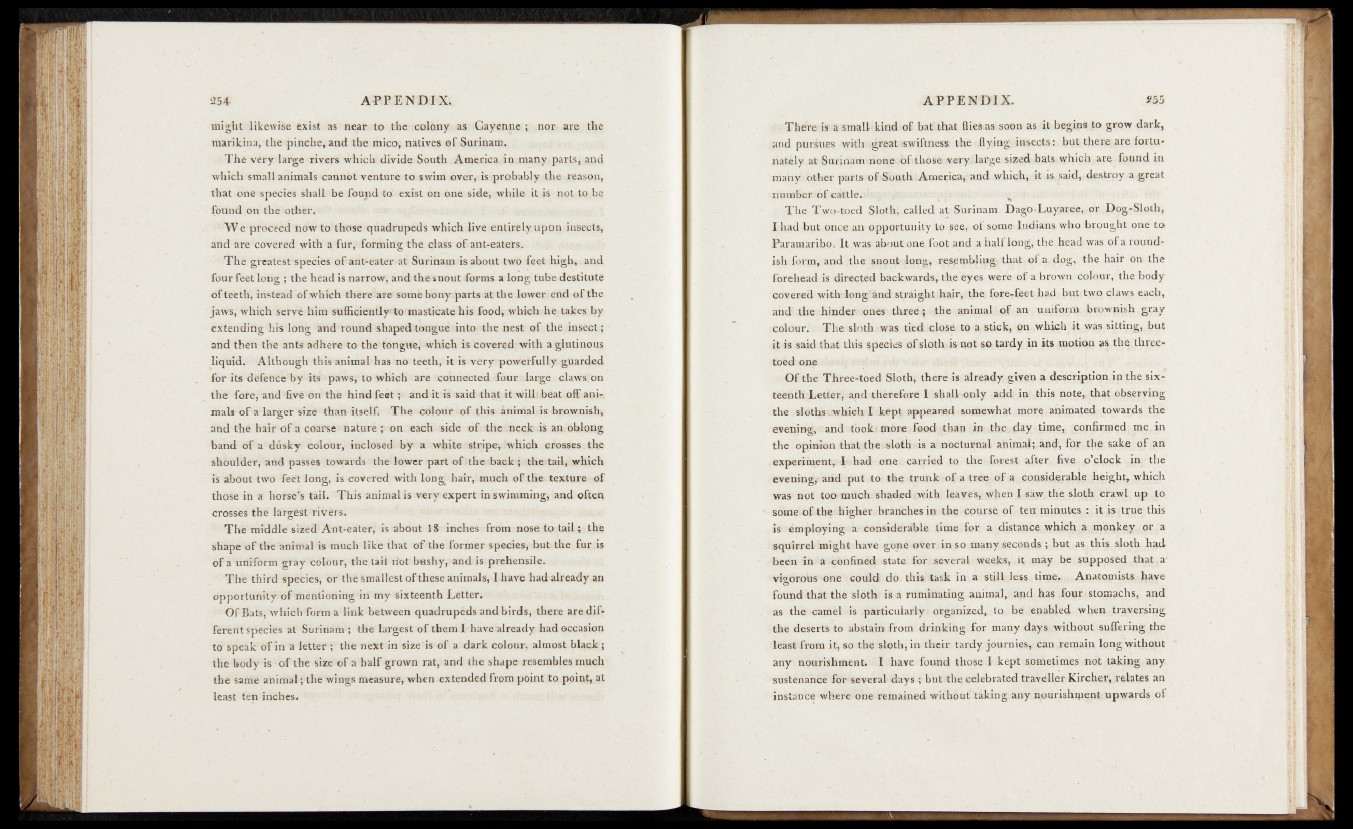
might likewise exist as near to the colony as Cayenne ;; nor are the
marikina, the pinche, and the mico, natives ©f Surinam.
The very large rivers which divide South America in tnanypartsr,a,qd
which small animals cannot venture to swim over, is-probably the .reason,
that one species shall be found to exist on one side, while it is not to be
found on the other.
W e proceed now to those quadrupeds which live entirel.y upon insects,
and are covered with aofury forming the class of ant-eaters.
The greatest species of ant-eater at Surinam is about two feet high,- and
four feet long ; the head is narrow, and the snout forms a long tube destitute
o f teeth, instead of which there'are some bony parts at the lower end o f the
jaws, which serve him sufficiently)to masticate his foody which .he takes by-
extending his long and round shaped tongue into the nest of the insect;
and then the ants adhere-to the tongue, which is Covered-with a glutinous
liquid. Although this animal has no teeth, it is very powerfully guarded
for its defence by- its piaws, to which are connected four large claws on
the fore, and -five on the hind feet; : and it is said that it will? beat off aoi-.
mals of a-larger size than itself. The colour o f this animal is brownish,
and the hair o f a coarse nature; on each side of the neck.is an. oblong
band o f a dusky colour, inclosed by a white stripe* which crosses the
shoulder, and passes towards the lower part of the back ; the tail, which
is about two feèl long, is covered with long hair, much of the texture o f
those in a horse’s tail. This animal is very expert in swimming*’and often
crosses the largèSt-Tivérs.
The middle sized: Ant-eatery is about 18 inches from nose to tail j the
shape o f the animal is much like that o f the former species, but the fur is
Of a uniform grèy colour, the tail riotbHshy, and is prehensile.
The third species, or the smallest ofthese animals, I have had already an
opportunity, of mentioning in my-sixteenth Letter.
Of Bats, w hich form a link between quadrupeds and birds, there are different
species at Surinam ; the largest of them I have already had occasion
to speak' of in a letter; the next in size is of a dark colour, almost black ;
the body is of the size of a half grown rat, and the shape resembles much
the same animal; the wings measure, when extended from point to point, at
least ten inches.
Thdre i» a smdkkindiof: batlthat fliesoassojon ass!i t begins #o grow dark,
and pursues with- great, swiftness- th e , iflydogl isi§ects: but there; are fortunately
at SarinamtnoHe*.)ofdh®soi«ery>ilarge si^ejdjb^s-whi^hr ate found in
ihahy o tte r partsrofiSbuith America, and which, At is»,said, destrpy a groat
The Two-toed Sloth,called at Surinam Dago - Luyaree,or Dog- Sloth,
I had but once an opportunity to see,- of-some Indians who brought one to>
Paramaribo, It was about one foot and a halt long; the headi-was of a roundish
foraa, and the snout-long, resembling-» that-of a^log, the hair on the
forehead is directed backwards, the eyes were of a brown dolour, the body
covered witblung'andstraight hair, tjbg
and? the hinder ones three») -the • animal, ipf an uniform bipwnish gray
colour. The slnth.was tied/Close to a; stick, pn which it was shtingj hut
it is said that this species ofsf&thsijs not ^otardy in its motipn as t^^thRee-
toed one
Of the Three-toed Sloth, there Is aiready|,giyen a description,in the sixteenth
Letter* and therefore I shall iO.nly ^dd in this note, that f l^cyying
the sloths which I kept appeared somewhat more animated towards the
evening, and >tbok? more food than in,th.e<..day time,. yppufirmed; jne -in
the Opinion that the »sloth is a nocturnal animal;,and’, for tjie sake|of a,n
expepimenvlohad one .carried tn !^e*;Jp§g$|- after .five- o’clock in the
evening*, arid put to the trunk .of a tree of a considerable
was not ton much . shaded .-with leaveair i^yhen thp sloth; crawl, up ^o
some o f theuhigher branches in the. course o f ten minutes it is true this
is- employing a considerable time for a distance which a ;monkey o r . a
squirrel might have gone over? in so many gecppds; but as this sloth had
been in a confined- state for several weeks,.>it; may be supposed.that.a'
vigorous one could do this, .task in.a timp,r;. Anatomists, have
found that the sloth is <a ruminating apimal, and has .four stomaghs, and
as the camel is particularly * organized, to, be ,enabled when traversing
the deserts to abstain from; drinking for many days* without, isulferipg the
least from if, so the slothy in their, tardy. j®wrni4%f.can remain ljWgyyithopt
any nourishment. I have found those I kept soinetimes no.t taking apy
sustenance far- several days ;; but .‘the celebrated traveller Kircheiv relates an
instance where one remained without’ taking.any nourishment upwardsof